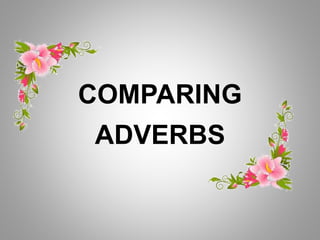Comparing adverbs
- 2. WHAT IS AN ADVERB? Adverb is a word that modifies a verb, an adjective or another adverb.
- 3. Find the adverb in the following sentences and identify the word it modifies. We live temporarily in this world.
- 4. Find the adverb in the following sentences and identify the word it modifies. We live temporarily in this world.
- 5. Find the adverb in the following sentences and identify the word it modifies. The secretary read her report briefly
- 6. Find the adverb in the following sentences and identify the word it modifies. The secretary read her report briefly
- 7. Find the adverb in the following sentences and identify the word it modifies. The policemen arrived shortly after the incident.
- 8. Find the adverb in the following sentences and identify the word it modifies. The policemen arrived shortly after the incident.
- 9. Find the adverb in the following sentences and identify the word it modifies. The children sang loudly.
- 10. Find the adverb in the following sentences and identify the word it modifies. The children sang loudly.
- 11. Let me introduce you to....
- 13. Eric says.... I run faster.
- 14. And Marc also says.... I run fastest of all.
- 15. What are the boys doing?
- 16. Paul: âI run fast.â Eric: âI run faster.â Marc: âI run fastest of all.â What do the underlined words show or describe?
- 17. Lets analyze the following examples. Positive Comparative Superlative hard harder hardest gracefully less gracefully least gracefully more most little less least
- 18. How many degrees of comparison are there? ïAdverbs have three degrees of comparison â positive, comparative, and superlative.
- 19. ïThere is no comparison made in the positive degree. ïIn the comparative degree, two things are being compared. ïIn the superlative degree, more than two things are compared.
- 20. ïMost adverbs with one syllable form their comparison by adding âer or âest. ïMost adverbs with two or more syllables use more/less or most/least to for their comparative and superlative form. ïSome adverbs have irregular comparative and superlative forms
- 21. ïAdverbs have three degrees of comparison â positive, comparative, and superlative. ïThere is no comparison made in the positive degree. ïIn the comparative degree, two things are being compared. ïIn the superlative degree, more than two things are compared. ïMost adverbs with one syllable form their comparison by adding âer or âest. ïMost adverbs with two or more syllables use more/less or most/least to for their comparative and superlative form. ïSome adverbs have irregular comparative and superlative forms





















